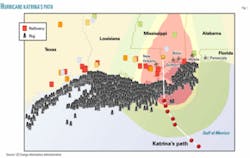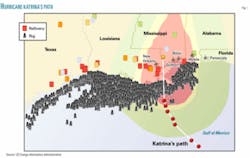Industry assesses Hurricane Katrina’s impact
While the remnant of Hurricane Katrina continued to flood parts of the southern US at presstime last week, oil and natural gas companies began assessing the storm’s damage along the Gulf Coast.
“There is still very little information regarding Katrina’s impact to the Gulf of Mexico,” said analysts on Aug. 30 in the Houston offices of Raymond James & Associates Inc. “Clearly, we think (based purely on speculation) that there is likely to be some significant damage to Gulf of Mexico infrastructure.”
As of Aug. 31, the US Minerals Management Service reported 482 production platforms and 79 drilling rigs remained evacuated in the Gulf of Mexico, with 1.4 million b/d of oil and 8.3 bcfd of natural gas production still shut in. Cumulative production lost because of Katrina during the period of Aug. 26-31 totaled 6.1 million bbl of oil and 34.2 bcf of natural gas.
When Hurricane Ivan hit the US Gulf Coast in September 2004, it forced the evacuation of 69 rigs and 575 production platforms. Ivan also proved to be the most damaging hurricane ever to hit the US offshore oil and gas industry, destroying 7 offshore platforms, damaging 24 others, and wrecking segments of 102 pipelines before making landfall.
Upstream, production
As Katrina came ashore Aug. 29, an accommodation unit owned by Petroleos Mexicanos undergoing work at a shipyard broke free of its moorings and struck the Cochrane-Africatown USA bridge along US 98 in Mobile County, Ala., said Raymond James analysts.
Royal Dutch Shell PLC reported that an aerial inspection of its Mars field production platform indicated heavy damage to its upper deck.
Newfield Exploration Co. said an aerial survey of its operations in the eastern Gulf of Mexico indicates that its A production platform at Main Pass 138 was lost in the storm. That facility was producing 1,500 b/d of oil (gross) prior to being shut in before the storm, and Newfield was operator with 92% working interest.
Diamond Offshore Drilling Inc. said the semisubmersible drilling rig Ocean Voyager during the hurricane broke free from its moorings on Mississippi Canyon Block 711, operated by ATP Oil & Gas Corp., and drifted 9 miles north of its prestorm position. A crew boarded the rig Aug. 30 to secure it and assess its condition. Diamond Offshore’s Ocean Warwick jack up was badly damaged after the storm set it adrift from its previous location 12 miles off Louisiana in 200 ft of water on Main Pass Block 299.
Louisiana accounts for 25% of the oil and gas produced by Clayton Williams Energy Inc., Midland, Tex. The independent suspended 95% of its Louisiana production because of Katrina. “A storm of this magnitude can cause a lot of damage to production platforms and pipeline infrastructures. And as we learned with Hurricane Ivan last year, the availability of field services and equipment will very likely be limited. Any significant delays in restoring production could adversely affect our results of operations,” said Clayton W. Williams, president and chief executive.
Port Fourchon, La., the low-lying coastal base for three quarters of support services for deepwater oil and gas facilities in the Gulf of Mexico, remained shut Aug. 31 because of storm damage. “We have yet to enter because there are several large vessels on the highway in the port itself,” said Port Director Ted Falgout.
Midstream, downstream
No damage to offshore pipelines was reported as of Aug. 31. “We’re assessing the situation. Systems along the coast were either closed or derated prior to landfall,” said Raymond Paul, director of public affairs for the Association of Oil Pipelines, which represents more than 50 of the nation’s largest pipeline companies.
Paul said that several of those pipelines were working to restore operations. “The main challenges are the lack of electricity and the availability of product. There won’t be much to put through the pipelines until the refineries are up and running again,” he said.
It will take weeks-perhaps months-to bring flooded, powerless Gulf Coastrefineries back to operation and to restore oil and natural gas production to its former levels, said observers.
Raymond James noted “several refinery outages” along the Gulf Coast after Kristina moved through, including “some that are only expected to last a day or 2, some that may be out for several weeks, depending on the restoration of power.”
The Louisiana Offshore Oil Port-the biggest US port for importing crude-survived Katrina without damage but had not yet resumed oil imports due to the lack of electrical power.
Entergy Corp., the utility that provides power for the pipeline system connecting LOOP to Gulf Coast refineries, said it would take weeks to rebuild its electric power delivery system in Louisiana, where 80% of its customers were without power.
Valero Energy Corp. said it could be as long as 2 weeks before its St. Charles refinery can resume production. The refinery has no power, and officials said it could take as long as 3 days to restore power. The company reported 3 ft of floodwater in two units and minor damage to its cooling towers. However, officials said no major damage is apparent, and there was no immediate evidence of spills or leaks.
Mary Rose Brown, a representative of Valero, said, “We can’t do much without power or people. As you know, [Louisiana] officials are discouraging folks from returning to the area” because of flooding, storm damage, and the resulting lack of shelter, power, and potable water.
“We do have a small crew working to pump out water from the FCC unit and the alkylation unit. We are mobilizing folks from our other refineries to assist in the repair and start-up activities, but we can’t do anything until folks are allowed to return to the area and we get power to the refinery,” Brown said. Valero’s 78,000 b/d Krotz Springs refinery “remains at reduced rates due to pipeline power problems,” she said.
Operations at Chalmette Refining LLC’s 187,200 b/d facility, a joint venture of ExxonMobil Corp. and Petroleos de Venezuela SA, remained shut down, and all employees were advised not to report to work until further notice.
However, ExxonMobil’s 494,000 b/d refinery and chemical operations in Baton Rouge continued to run at reduced rates until normal feedstock supply resumes. All employees were advised to return to work.
Raymond James analysts said: “Approximately 1.79 million b/d of refining capacity (10% of the nation’s total) has been suspended indefinitely due to shut-ins at eight refineries. Of these, the shortest reported restart estimate is 2 weeks. An additional total of 684,000 b/d of capacity is running at reduced rates at three other refineries.”
Units completely shut down included Chevron Corp.’s 325,000 b/d refinery in Pascagoula, Miss., Valero Energy’s St. Charles refinery, Motiva Enterprises LLC’s 255,000 b/d facility in Convent, La., and 242,000 b/d refinery in Norco, La., ConocoPhillips’ 247,000 b/d Alliance refinery, Marathon Oil Corp.’s 245,000 b/d Garyville, La., refinery, Chalmette Refining LLC’s 187,200 b/d facility; and Murphy Oil Corp.’s Meraux, 125,000 b/d refinery.
Other refiners did not make any projections for bringing their units back online.
Still, said Jeffrey Morrison, a credit analyst at Standard & Poor’s, a division of The McGraw-Hill Cos. Inc., said, “High commodity prices throughout 2005 are expected to provide some financial cushion for affected companies to withstand the expected temporary service and production disruptions and restoration efforts.”
Sabine Pipe Line LLC on Aug. 28 closed the Henry Hub, the central point for natural gas deliveries in Louisiana, as Katrina approached shore but reopened that facility the afternoon of Aug. 29. A Houston subsidiary of Chevron, Sabine Pipe Line owns and operates the Henry Hub.
Katrina already has had twice the impact on crude prices and caused natural gas prices to climb 40% more than did Ivan, said James Williams of WTRG Economics.
SPR oil
On Aug. 31, President George W. Bush authorized the US Department of Energy to take crude from the Strategic Petroleum Reserve (SPR) for refiners that may be short of supplies. “Over the next few days, we will continue to gain more information on the specific needs and then be able to make a better determination on how we can help,” said Sec. of Energy Samuel W. Bodman.
The supply of SPR crude “is likely to be 1-3 million bbl,” said Raymond James analysts. However, they noted, “The main problem now for the US refined product market is not a shortage of crude oil (which is what the SPR contains) but rather refining capacity, a substantial proportion of which remains shut down due to hurricane damage. While the SPR oil may be useful in certain cases, in general the bottleneck will be at the refinery level.”
Since two of the SPR facilities are in Louisiana and may be subject to the same flooding and lack of electric power as the refineries, some observers questioned whether the emergency supply of crude can be lifted and transported. SPR officials, however, said the Louisiana facilities are operational.
Officials at the International Energy Agency in Paris said European emergency stockpiles could be tapped and shipped across the Atlantic at the US government’s request. “This is not likely to be needed, again, because crude oil is not the main issue now,” said Raymond James analysts. “However, some European IEA members have large motor gasoline stockpiles. This could be useful if US refineries do not recover for a lengthy period of time.”
US gasoline inventories currently are below historical averages, analysts said. On Aug. 31, the Energy Information Administration reported US gasoline stocks fell by 500,000 bbl to 194.4 million bbl during the week ended Aug. 26. Commercial inventories of crude, excluding SPR, plunged by 1.5 million bbl to 321.4 million bbl, well above the upper end of the average range for this time of year. Distillate fuel stocks jumped by 2.7 million bbl to 135.2 million bbl, with heating oil accounting for most of that increase.
During that same week, the input of crude into US refineries increased by 572,000 b/d to 16.2 million b/d, with refineries operating at 97.1% of capacity. However, US crude imports declined by 114,000 b/d to 10.5 million b/d.
Fuel standard waiver
In response to fuel supply problems caused by the hurricane, the US Environmental Protection Agency, on Aug. 31 waived volatility and sulfur standards nationwide for gasoline and diesel.
The agency a day earlier had taken the same step for Louisiana, Mississippi, Alabama, and Florida.
“It has become clear that the consequences of the hurricane have become more widespread,” EPA Administrator Stephen L. Johnson said when he announced expansion of the waiver.
Suspension of the volatility and sulfur standards, established under the Clean Air Act, will help gasoline and diesel move to areas of highest demand.
The waivers were effective through Sept. 15, the end of the summertime period when ozone pollution is most severe.✦

